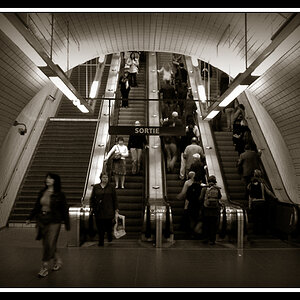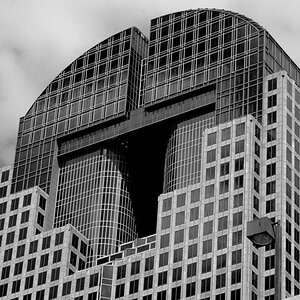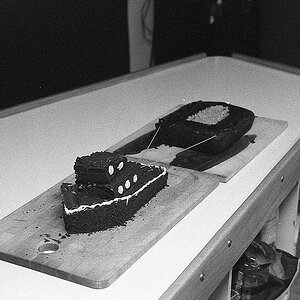Steph
No longer a newbie, moving up!
- Joined
- Oct 18, 2006
- Messages
- 1,314
- Reaction score
- 0
- Location
- Steventon, Oxfordshire, UK
- Can others edit my Photos
- Photos NOT OK to edit
I see a lot of questions about which entry level dSLR to buy on this forum. As I went through this process recently, I thought it might be of interest to others to explain how I went about it. If nobody is interested, so be it; I will just have wasted a couple of hours typing this.
Disclaimer
This is in no way a how-to guide on buying a dSLR camera, It is just my experience about what I looked at before taking a decision based on my needs and requirements. Please don’t try to convince me that I bought the wrong camera and that for the same amount of money I should have bought so and so instead. I am not double guessing myself here and I don't expect your approval.
Background
For years I have been shooting mainly landscapes with film (35mm with a Spotmatic F and MF with a Bronica SQ/SQA) and I am very happy with the results and never felt the need to go digital until now. The recent birth of our daughter (don’t worry, I won’t bore you with pictures!) prompted me to look at a dSLR/flashgun combination to be able to take decent pictures indoors and to be able to share them easily with friends and family. I was therefore in the market for a new (just for peace of mind) dSLR.
Requirements
I am not exactly new to photography so I knew fairly precisely what I wanted from my dSLR/flashgun in terms of features.
First there are a few things I did NOT look at because they were irrelevant to me:
1 - FPS. I am used to frame rate much slower than 1 frame per minute with my cameras. I don’t need speed.
2 - Number of AF points. On the rare occasions when I used an AF camera I always used the central AF point and recomposed. It works fine for me that way.
3 - Resolution. The pictures taken with the camera will not be printed bigger than 8x10. All currently available dSLRs are able to achieve good quality prints at that size.
4 - Lenses, accessories selection. With this equipment I am NOT buying into a system. I just want to buy a body, a kit lens and a flashgun. That’s it! If I want to spend more money on photographic equipment I would have much better ways to spend my money than on building a complete digital setup.
5 - Live view. I don’t need it.
6 - Image stabilisation. I don’t need it.
More importantly now, the things I wanted from the setup:
1 - Budget. Less than £600 from a reputable dealer for camera body, kit lens and flashgun.
2 - A flash from the same brand as the camera. I admit I am fairly ignorant about flash photography, so I decided to go with the same brand for the flash and camera to use the capabilities of the body to the full in terms of flash features. It does not have to be very powerful but has to be able to be bounced of a ceiling/wall.
3 - Small and light. If that camera is going to get used, it has to be small and light has it will not replace my other cameras but at best will be used alongside. I can’t carry a heavy camera such as Canon 5D or Pentax K20D alongside my Bronica system.
4 - Fairly well built. I know that within my budget I cannot expect a sturdy metal body but I expect a fairly solid camera that does not look too cheap.
5 - Be able to record high quality JPEG and RAW at the same time. I will share the JPEGs with friends and family but want to be able to edit the RAW files if the need arises.
6 - Easy to use and handle. I know that an overly complicated camera won’t get used much. Similarly, if it does not feel right in my hand I will be reluctant to use it.
7 - Be able to use older manual focus lenses. I have a few Zuiko OM and Pentax M42 lenses that I would like to use on the camera.
8 - Kit lens of acceptable quality. The kit lens will be my only lens. Therefore I expect decent quality (then again I am aware that within my budget I won’t get Canon L quality glass).
The contenders (within my budget. Prices from www.warehouseexpress.co.uk).
Sony a200 + 18-70mm + HVL-F42 Flashgun = £378
Nikon D40 + 18-55mm + SB600 Speedlight = £418
Nikon D60 + 18-55mm + SB600 Speedlight = £468
Olympus E-420 + 14-42mm + FL-36R Wireless Flashgun = £512
Canon EOS 1000D +18-55mm + Speedlite 430 EXII = £518
Sony a350 + 18-70mm + HVL-F42 Flashgun = £546
Pentax K200D +18-55mm + AF360 FGZ Flashgun = £580
Unfortunately, amongst those cameras, some did not even make it to the first round of my decision making. The D60 was dropped early as, to me, it is nothing more than a D40 with a few more megapixels (which, I believe, did not do anything good for image quality). The 2 cameras from Sony were also forgotten quickly. No rationale for that. I guess I don’t perceive Sony as a camera manufacturer (maybe if they were Minoltas it would be different). Also, I find their cameras ugly (particularly the shiny piece of plastic around the shutter release button) and the Carl Zeiss branded lenses don’t make up for that.
The contenders in the next round are therefore the Nikon D40, the Olympus E-420, the Canon EOS 1000D and the Pentax K200D and their associated flashguns. To determine the winner, I attributed points to the cameras (from 1 to 4, 10 points in total) according to different criteria and I tried to explain how the points were awarded. At the end, the camera with most points wins and gets to join my camera bag. Easy!!
Weight and size (Body with batteries)
1 - Olympus E-420: 440 g, 130x91x53 mm. 4 points
2 - Canon EOS 1000D: 502 g, 126x98x65 mm. 3 points
3 - Nikon D40: 522 g, 124x94x64mm. 2 points
4 - Pentax K200D: 690 g, 134x95x74 mm. 1 point
The Olympus is the clear winner in terms of weight and size as it is the smaller dSLR on the market, only dwarfed by the micro four thirds Panasonic Lumix DMC-G1 (not strictly speaking a SLR and out of my budget).
Build quality
1 - Pentax K200D. 4 points
2 - Olympus E-420. 3 points
3 - Canon EOS 1000D and Nikon D40. 1.5 points each
The Pentax is the clear winner here (probably at the expense of extra weight). It feels
better built than the other 3. Then comes the Olympus, which IMO is miles ahead of the Canon and Nikon. These 2 feel equally plasticy and cheap.
Ergonomics/Ease of use
1 - Olympus E-420. 4 points
2 - Pentax K200D. 3 points
3 - Nikon D40. 2 points
4 - Canon EOS 1000D. 1 point
That’s a difficult one as I did not have the opportunity to play with all the cameras for extended periods of time. Moreover, how a camera feels and fits in one’s hand is down to personal taste. To my surprise the Olympus came first because it is very easy to hold despite its lack of a proper grip (its lightness probably helps here). It reminded the old (grip-less) SLRs I am used to (Pentax Spotmatic and Olympus OM-1), which to me is a good thing. The Canon came last as I don’t like the position of the control wheel (I prefer to use my thumb to change the settings). Between the Pentax and the Nikon I preferred the former for no obvious reasons. It just felt better in my hand.
Image format (RAW + high quality JPEG)
1 - Olympus E-420 and Canon EOS 1000D. 3.5 points each
3 - Pentax K200D and Nikon D40. 1.5 points each
As far as I am aware only the Olympus and the Canon are able to record both RAW and high quality JPEG at the same time (this information is not easy to find from manufacturers’ websites so I don’t know for sure).
Compatibility with older lenses
1 - Olympus E-420. 4 points
2 - Pentax K200D. 3 points
3 - Canon EOS 1000D. 2 points
4 - Nikon D40. 1 point
The Olympus wins easily here. Due to its short flange distance you can mount virtually any older lenses (including M42 and OM) via simple mechanical (no glass element) adapters, which are readily available and with which you can achieve infinity focus. The Pentax can easily accept M42 lenses (and the wonderful manual K-mount lenses from the 80s). but not the Zuiko OM lenses. There is an adapter for the Canon to use M42 lenses (but not OM lenses AFAIK). The Nikon is useless in terms of using older lenses other than Nikkors.
Kit lens quality
1 - Olympus E-420. 4 points
2 - Pentax K200D. 3 points
3 - Nikon D40. 2 points
4 - Canon EOS 1000D. 1 point
This is purely based on reviews from the Internet and various magazines. Based on what I read (and perceived from these reviews) the Olympus offers the better kit lens in terms of image quality with the Pentax a fairly close second. The Canon kit lens is the worst from what I read.
And the winner is:
1 - Olympus E-420. 22.5 points
2 - Pentax K200D. 15.5 points
3 - Canon EOS 1000D. 12 points
4 - Nikon D40. 10 points
So, the Olympus is the clear winner. I think size and price were decisive in its victory. I quite liked the Pentax as well but it is not as good in terms of size and compatibility with my older lenses and it is more expensive. The Canon and Nikon are behind because they feel incredibly cheap and plasticy and IMO offer poor value for money (poor build quality and very average kit lens). Overall, the Olympus is not my ideal camera but it is the best compromise for my needs.
I now placed an order for the Olympus E-420, with the FL-36R flashgun, a Crumpler bag, a couple of memory cards, a spare battery, rechargeable AA batteries (for the flash) and a charger. Once I have used the camera for a while, I will try to update this thread to see if I made the right decision and what it’s like to use the Olympus. I am sure I will discover useful features that I missed during all my research but probably also a few quirks.
Thanks for reading the whole thread.
Disclaimer
This is in no way a how-to guide on buying a dSLR camera, It is just my experience about what I looked at before taking a decision based on my needs and requirements. Please don’t try to convince me that I bought the wrong camera and that for the same amount of money I should have bought so and so instead. I am not double guessing myself here and I don't expect your approval.
Background
For years I have been shooting mainly landscapes with film (35mm with a Spotmatic F and MF with a Bronica SQ/SQA) and I am very happy with the results and never felt the need to go digital until now. The recent birth of our daughter (don’t worry, I won’t bore you with pictures!) prompted me to look at a dSLR/flashgun combination to be able to take decent pictures indoors and to be able to share them easily with friends and family. I was therefore in the market for a new (just for peace of mind) dSLR.
Requirements
I am not exactly new to photography so I knew fairly precisely what I wanted from my dSLR/flashgun in terms of features.
First there are a few things I did NOT look at because they were irrelevant to me:
1 - FPS. I am used to frame rate much slower than 1 frame per minute with my cameras. I don’t need speed.
2 - Number of AF points. On the rare occasions when I used an AF camera I always used the central AF point and recomposed. It works fine for me that way.
3 - Resolution. The pictures taken with the camera will not be printed bigger than 8x10. All currently available dSLRs are able to achieve good quality prints at that size.
4 - Lenses, accessories selection. With this equipment I am NOT buying into a system. I just want to buy a body, a kit lens and a flashgun. That’s it! If I want to spend more money on photographic equipment I would have much better ways to spend my money than on building a complete digital setup.
5 - Live view. I don’t need it.
6 - Image stabilisation. I don’t need it.
More importantly now, the things I wanted from the setup:
1 - Budget. Less than £600 from a reputable dealer for camera body, kit lens and flashgun.
2 - A flash from the same brand as the camera. I admit I am fairly ignorant about flash photography, so I decided to go with the same brand for the flash and camera to use the capabilities of the body to the full in terms of flash features. It does not have to be very powerful but has to be able to be bounced of a ceiling/wall.
3 - Small and light. If that camera is going to get used, it has to be small and light has it will not replace my other cameras but at best will be used alongside. I can’t carry a heavy camera such as Canon 5D or Pentax K20D alongside my Bronica system.
4 - Fairly well built. I know that within my budget I cannot expect a sturdy metal body but I expect a fairly solid camera that does not look too cheap.
5 - Be able to record high quality JPEG and RAW at the same time. I will share the JPEGs with friends and family but want to be able to edit the RAW files if the need arises.
6 - Easy to use and handle. I know that an overly complicated camera won’t get used much. Similarly, if it does not feel right in my hand I will be reluctant to use it.
7 - Be able to use older manual focus lenses. I have a few Zuiko OM and Pentax M42 lenses that I would like to use on the camera.
8 - Kit lens of acceptable quality. The kit lens will be my only lens. Therefore I expect decent quality (then again I am aware that within my budget I won’t get Canon L quality glass).
The contenders (within my budget. Prices from www.warehouseexpress.co.uk).
Sony a200 + 18-70mm + HVL-F42 Flashgun = £378
Nikon D40 + 18-55mm + SB600 Speedlight = £418
Nikon D60 + 18-55mm + SB600 Speedlight = £468
Olympus E-420 + 14-42mm + FL-36R Wireless Flashgun = £512
Canon EOS 1000D +18-55mm + Speedlite 430 EXII = £518
Sony a350 + 18-70mm + HVL-F42 Flashgun = £546
Pentax K200D +18-55mm + AF360 FGZ Flashgun = £580
Unfortunately, amongst those cameras, some did not even make it to the first round of my decision making. The D60 was dropped early as, to me, it is nothing more than a D40 with a few more megapixels (which, I believe, did not do anything good for image quality). The 2 cameras from Sony were also forgotten quickly. No rationale for that. I guess I don’t perceive Sony as a camera manufacturer (maybe if they were Minoltas it would be different). Also, I find their cameras ugly (particularly the shiny piece of plastic around the shutter release button) and the Carl Zeiss branded lenses don’t make up for that.
The contenders in the next round are therefore the Nikon D40, the Olympus E-420, the Canon EOS 1000D and the Pentax K200D and their associated flashguns. To determine the winner, I attributed points to the cameras (from 1 to 4, 10 points in total) according to different criteria and I tried to explain how the points were awarded. At the end, the camera with most points wins and gets to join my camera bag. Easy!!
Weight and size (Body with batteries)
1 - Olympus E-420: 440 g, 130x91x53 mm. 4 points
2 - Canon EOS 1000D: 502 g, 126x98x65 mm. 3 points
3 - Nikon D40: 522 g, 124x94x64mm. 2 points
4 - Pentax K200D: 690 g, 134x95x74 mm. 1 point
The Olympus is the clear winner in terms of weight and size as it is the smaller dSLR on the market, only dwarfed by the micro four thirds Panasonic Lumix DMC-G1 (not strictly speaking a SLR and out of my budget).
Build quality
1 - Pentax K200D. 4 points
2 - Olympus E-420. 3 points
3 - Canon EOS 1000D and Nikon D40. 1.5 points each
The Pentax is the clear winner here (probably at the expense of extra weight). It feels
better built than the other 3. Then comes the Olympus, which IMO is miles ahead of the Canon and Nikon. These 2 feel equally plasticy and cheap.
Ergonomics/Ease of use
1 - Olympus E-420. 4 points
2 - Pentax K200D. 3 points
3 - Nikon D40. 2 points
4 - Canon EOS 1000D. 1 point
That’s a difficult one as I did not have the opportunity to play with all the cameras for extended periods of time. Moreover, how a camera feels and fits in one’s hand is down to personal taste. To my surprise the Olympus came first because it is very easy to hold despite its lack of a proper grip (its lightness probably helps here). It reminded the old (grip-less) SLRs I am used to (Pentax Spotmatic and Olympus OM-1), which to me is a good thing. The Canon came last as I don’t like the position of the control wheel (I prefer to use my thumb to change the settings). Between the Pentax and the Nikon I preferred the former for no obvious reasons. It just felt better in my hand.
Image format (RAW + high quality JPEG)
1 - Olympus E-420 and Canon EOS 1000D. 3.5 points each
3 - Pentax K200D and Nikon D40. 1.5 points each
As far as I am aware only the Olympus and the Canon are able to record both RAW and high quality JPEG at the same time (this information is not easy to find from manufacturers’ websites so I don’t know for sure).
Compatibility with older lenses
1 - Olympus E-420. 4 points
2 - Pentax K200D. 3 points
3 - Canon EOS 1000D. 2 points
4 - Nikon D40. 1 point
The Olympus wins easily here. Due to its short flange distance you can mount virtually any older lenses (including M42 and OM) via simple mechanical (no glass element) adapters, which are readily available and with which you can achieve infinity focus. The Pentax can easily accept M42 lenses (and the wonderful manual K-mount lenses from the 80s). but not the Zuiko OM lenses. There is an adapter for the Canon to use M42 lenses (but not OM lenses AFAIK). The Nikon is useless in terms of using older lenses other than Nikkors.
Kit lens quality
1 - Olympus E-420. 4 points
2 - Pentax K200D. 3 points
3 - Nikon D40. 2 points
4 - Canon EOS 1000D. 1 point
This is purely based on reviews from the Internet and various magazines. Based on what I read (and perceived from these reviews) the Olympus offers the better kit lens in terms of image quality with the Pentax a fairly close second. The Canon kit lens is the worst from what I read.
And the winner is:
1 - Olympus E-420. 22.5 points
2 - Pentax K200D. 15.5 points
3 - Canon EOS 1000D. 12 points
4 - Nikon D40. 10 points
So, the Olympus is the clear winner. I think size and price were decisive in its victory. I quite liked the Pentax as well but it is not as good in terms of size and compatibility with my older lenses and it is more expensive. The Canon and Nikon are behind because they feel incredibly cheap and plasticy and IMO offer poor value for money (poor build quality and very average kit lens). Overall, the Olympus is not my ideal camera but it is the best compromise for my needs.
I now placed an order for the Olympus E-420, with the FL-36R flashgun, a Crumpler bag, a couple of memory cards, a spare battery, rechargeable AA batteries (for the flash) and a charger. Once I have used the camera for a while, I will try to update this thread to see if I made the right decision and what it’s like to use the Olympus. I am sure I will discover useful features that I missed during all my research but probably also a few quirks.
Thanks for reading the whole thread.
Last edited:


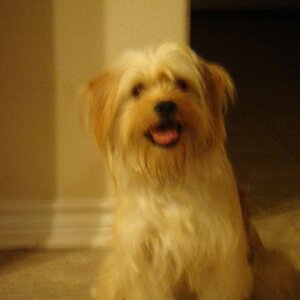
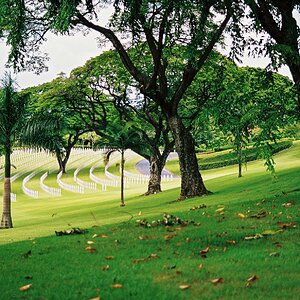
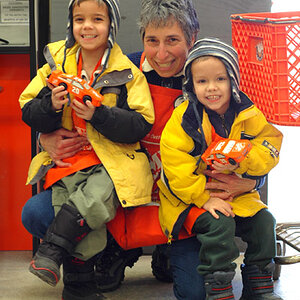
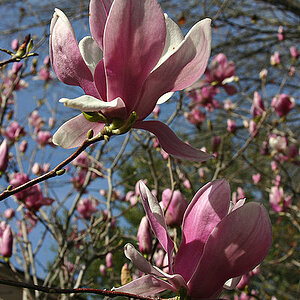
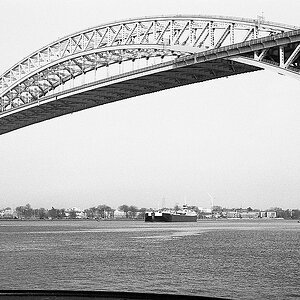
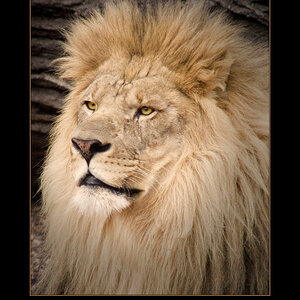
![[No title]](/data/xfmg/thumbnail/42/42024-bf0604d67b26c7acb5e4d59254692618.jpg?1619739981)
